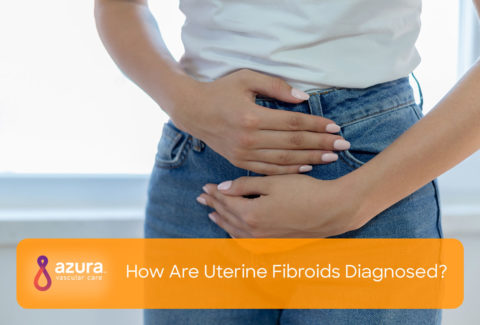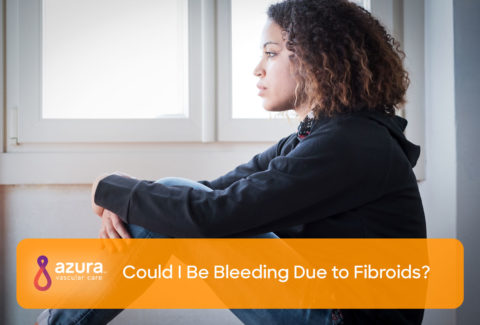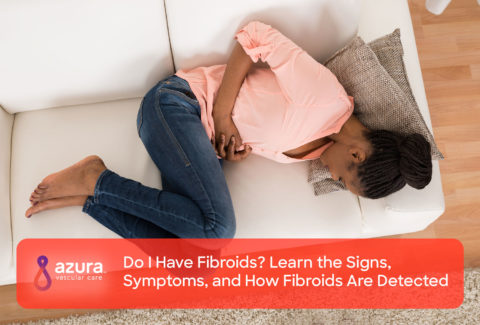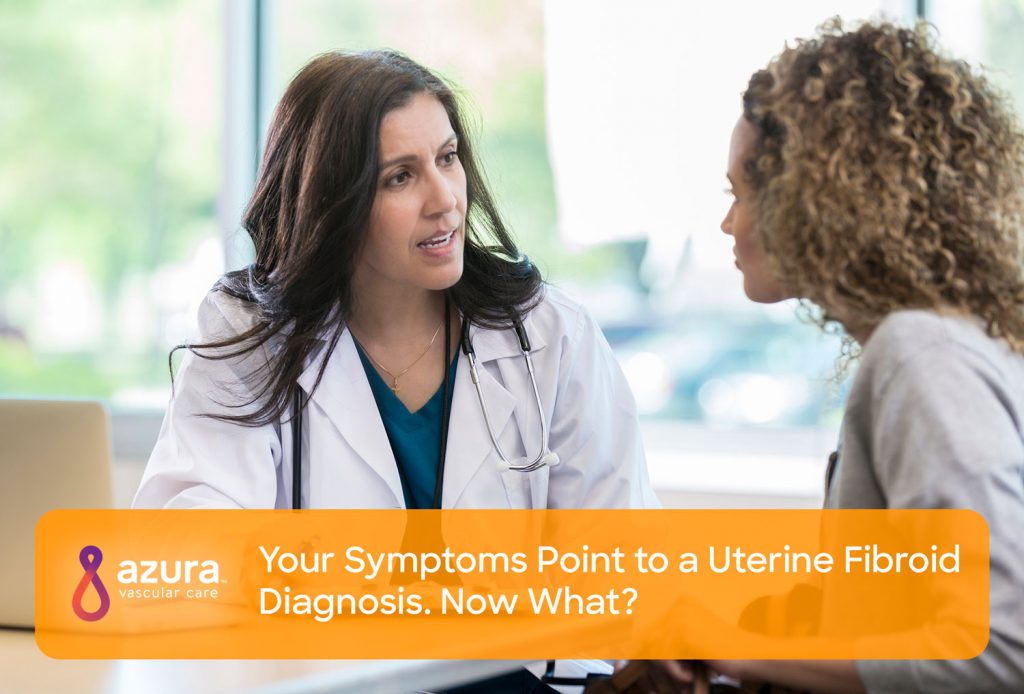
You’ve researched your symptoms and all signs are pointing to a uterine fibroid diagnosis. If you believe you have uterine fibroids, speak to your primary care provider or a gynecologist about your symptoms.
It’s a good idea to prepare in advance for your appointment, getting all your questions answered from, “How are uterine fibroids diagnosed?” to, “What are my treatment options?”
6 Points to Help Make the Most of Your Visit to Your Doctor
Being prepared for your appointment may lessen your anxiety and may help your doctor help you.
To prepare for your appointment: (1)
1. Write down all of the symptoms that you’re experiencing, even if you don’t think they’re related.
2. List all of the medications and herbal and vitamin supplements that you take, including the doses and how often you take them.
3. Bring a notebook or electronic device with you to jot down important information during your visit.
4. Make a list of questions to ask your doctor and list them in order of importance, just in case your visit is cut short. For example:
- How many fibroids do I have? How big are they?
- Are the fibroids growing on the inside or outside of my uterus?
- What kinds of tests do I need?
- Are there medications available to treat uterine fibroids or my symptoms?
- What side effects can I expect from these medications?
- How are fibroids treated?
- Will my uterine fibroids affect my ability to become pregnant?
- Can treatment of uterine fibroids improve my fertility?
5. You should also be prepared to answer questions about your health. Some questions your doctor might ask include: (1)
- Do you have a family history of uterine fibroids?
- How often do you have symptoms?
- How long have you noticed these symptoms?
- How severe are they?
- Do your symptoms seem to be related to your menstrual period?
- Does anything improve your symptoms?
- What makes your symptoms worse?
6. Don’t be shy: Ensure that you understand everything your doctor tells you, and don’t hesitate to ask additional questions.
How Are Uterine Fibroids Diagnosed?
Your doctor may be able to confirm if you have fibroids during a routine pelvic exam. Through a physical examination, your doctor can check the size of your uterus and for abnormalities in the shape of your uterus. If you have fibroids, your uterus may feel larger than normal or it may feel irregularly shaped. (2) Some fibroids may be too small to identify through a physical examination but can be detected with ultrasound or other types of imaging technology.
Some common types of imaging technology are: (2)
- Ultrasound, which uses sound waves to form the image
- Saline infusion sonography, which uses an injection of salt solution into the uterus to help create the ultrasound image
- Magnetic resonance imaging (MRI), which uses magnets and radio waves to create the image
- X-rays, which use a form of electromagnetic radiation to “see” into the body
- Computed tomography (CT) or computer-assisted tomography (also called a “CAT” scan), which scans the body with X-rays from many angles to create a more complete picture
Treatment Options for a Uterine Fibroid Diagnosis
If you received a uterine fibroids diagnosis but your fibroids aren’t causing heavy bleeding, pressure, or pain, and aren’t impeding any plans to get pregnant, you may not require treatment. When there are symptoms, however, there are a variety of uterine fibroid treatment options.
Your doctor may suggest over-the-counter analgesics, including acetaminophen (Tylenol®) and nonsteroidal anti-inflammatory drugs, such as ibuprofen (Motrin®, Advil®). (3) If you develop anemia due to heavy bleeding, you may be encouraged to increase your iron intake through diet, supplements, or both. (3)
Uterine fibroid embolization (UFE) is a minimally invasive treatment option. UFE safely and effectively shrinks fibroids by blocking blood flow to them. For women with mild to severe symptoms, it’s an alternative to surgery that offers symptomatic relief with quick recovery and no hospital stay, no cutting and no recurrence.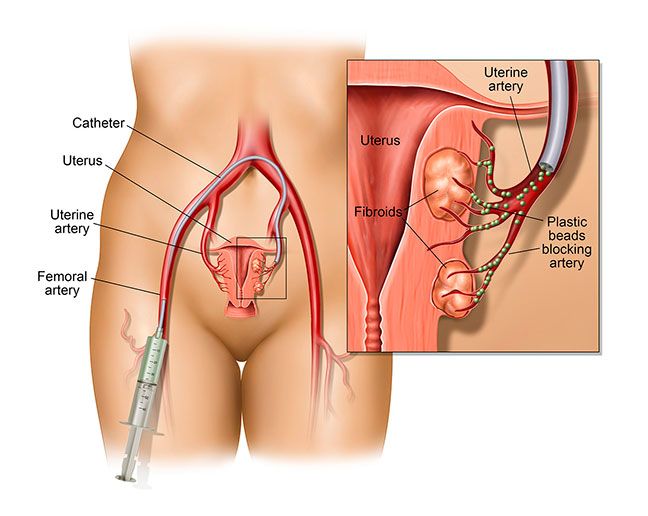
UFE doesn’t require general anesthesia. It’s performed under local anesthesia with the patient conscious, but sedated, and feeling no pain. The interventional radiologist makes a tiny nick in the skin in the groin in order to access the (femoral artery) or the wrist (radial artery), then, using real-time imaging, the physician guides a catheter through the artery to the site of the fibroid. He or she then places tiny medical-grade plastic spheres—the size of grains of sand—into the uterine arteries that supply blood to the fibroid. These spheres block the blood flow to the fibroid, causing them to shrink and die.
If you are considering surgery to treat your fibroids, the two most common surgical treatments are myomectomy, which removes only the fibroid, or hysterectomy, which removes the entire uterus. With surgery, there are certain risks that may include infection, scarring and blood loss.
It’s important to understand that several treatments are available to you and that surgery is not your only option. With technological and medical advancement, you have a choice in treating your fibroids. Make a decision, with the help of your doctor, based on your situation and diagnosis.
To learn if you’re a candidate for UFE, download our free information sheet, Understanding Uterine Fibroid Embolization, or call 844-UFE-CARE (833-2273) to schedule an appointment with a vascular specialist today.
Sources:
(1) Mayo Clinic. (2018, March 06). Uterine fibroids. Retrieved June 14, 2018, from https://www.mayoclinic.org/diseases-conditions/uterine-fibroids/diagnosis-treatment/drc-20354294
(2) US Department of Health and Human Resources. How are uterine fibroids diagnosed? – National Institutes of Health. Retrieved July 25, 2018, from https://www.nichd.nih.gov/health/topics/uterine/conditioninfo/how-diagnosed
(3) Harvard Health Publishing. (2008, July). What to do about fibroids – Harvard Health. Retrieved June 14, 2018, from https://www.health.harvard.edu/womens-health/what_to_do_about_fibroids
(4) University of Michigan. (2017, October 6). Uterine Fibroids. Retrieved June 14, 2018, from https://www.uofmhealth.org/health-library/hw183462#hw183603
(5) Tempest, M., RD. (2012, May). Uterine Fibroids and Nutrition – Studies Suggest Healthful Dietary Modifications May Cut Risk and Ease Symptoms. Retrieved June 14, 2018, from http://www.todaysdietitian.com/newarchives/050112p40.shtml
